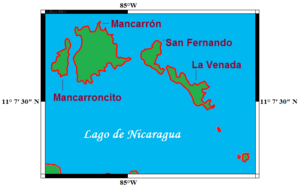Solentiname Islands facts for kids
Quick facts for kids
Solentiname Islands
|
|
|---|---|
|
Municipality
|
|

The Solentiname Islands
|
|
| Country | |
| Department | Río San Juan |
| Area | |
| • Total | 190 km2 (70 sq mi) |
| • Land | 38 km2 (15 sq mi) |
| Elevation | 257 m (843 ft) |
| Population | |
| • Total | 1,000 |
| • Density | 5.3/km2 (14/sq mi) |
The Solentiname Islands are a group of islands located at the southern end of Lake Nicaragua. This beautiful archipelago is part of the Río San Juan area in Nicaragua.
The islands were formed by volcanoes long ago. There are four main islands: Mancarroncito, Mancarrón, San Fernando, and La Venada. Around them are about 32 smaller islands. The highest point is on Mancarrón, reaching 257 meters above sea level. The Solentiname Islands are so special that they are a National Monument and a protected area in Nicaragua.
Contents
History of the Islands
The name "Solentiname" has an interesting story. Many people believe it comes from an old Nahuatl word. This word means "place of many guests." It suggests that these islands have always been a welcoming spot for visitors.
Exploring Solentiname's Geography
The Solentiname Islands are a true tropical paradise. They are covered with lush trees and plants. The islands are home to many colorful birds. You can spot different kinds of parrots and toucans here. In fact, there are 76 different bird species!
Amazing Wildlife of Solentiname
The waters around the islands are full of fish. About 46 different species live here. These include large tarpon and even freshwater sharks. The island of La Venada is famous for its deer. Its name, "La Venada," actually means "The Doe" in Spanish.
The islands get a lot of rain, mostly from May to December. The average temperature is around 26 degrees Celsius.
Art and Community Life
The peaceful and colorful nature of Solentiname has drawn many artists. Painters and woodcarvers live here alongside farmers and fishermen. The islands have a small population, less than 1,000 people. Life here is simple, with few modern conveniences like electricity or running water.
Mancarrón is the largest island. It is known for being the home of Ernesto Cardenal. He was a priest and poet who arrived in 1966. Father Cardenal helped create a special communal society for artists in the early 1970s. This community is still active today.
The Unique Art Movement
The artists in Solentiname developed their own special style of naïve art. This art is simple and colorful, often showing scenes from daily life and nature. A painter named Róger Pérez de la Rocha helped them.
There is a small art gallery on the islands. Here, local artists display their amazing works. You can find beautiful woodcarvings of birds and mobiles. They also create famous primitivist paintings. These paintings are full of bright colors and show the islands' rich wildlife and plants.
Tourism and Economy
Because of their natural beauty and unique art, the Solentiname Islands have become a place for ecotourism. This means tourism that focuses on nature and local culture. While still a quiet spot, the islands now have a few hotels for visitors.
Important Sites to Visit
The islands also have important archaeological sites. On San Fernando, you can see ancient petroglyphs. These are rock carvings of parrots, monkeys, and people.
Near the islands is the Los Guatuzos Wildlife Refuge. This large marsh is home to monkeys and alligators. The Solentiname National Monument includes the islands themselves and the surrounding lake areas.
Local Products
The people of Solentiname also grow various crops. These include avocado, cotton, sesame, corn, coffee, and cacao.
The famous writer Julio Cortázar even set parts of his story "Apocalipsis de Solentiname" on these islands. The story features Ernesto Cardenal and the community's art gallery.
See also
 In Spanish: Solentiname para niños
In Spanish: Solentiname para niños



